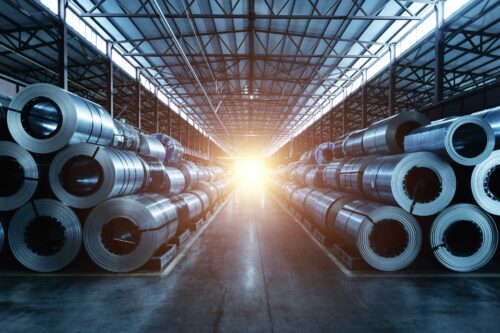
Knowing the Emissions of Your Steel Supply Chain
As you read this article, try to identify all the steel around you. You will find steel appliances in your home and steel in your tall office building, your car, and most human-made infrastructure. Steel is ubiquitous in the global economy. In recent years, the steel sector has received increased attention in the context of global decarbonization. At COP26 in Glasgow in the fall of 2021, establishing and growing the production of near-zero emissions steel was identified as one of the ambitious goals of the conference.
Simultaneously, the steel sector is in the early stages of adopting new manufacturing technologies that produce steel with lower greenhouse gas (GHG) emissions. There is also a growing demand for this low-emissions steel from end-users of steel like automakers and national governments. RMI’s new Steel Emissions Reporting Guidance is an important tool that can help promote decarbonization in the steel sector.
Decarbonization Pathways for the Steel Sector
Steel is either produced from iron ore (which is mined) or scrap (which is collected from end-of-life buildings, cars, or other infrastructure). Production from iron ore inherently requires more energy than production from scrap. This is due to the energy needed to separate oxygen from iron in the ore. Also, the traditional energy source for steelmaking with iron ore is coal, which further increases its emissions intensity. Conversely, scrap-based steelmaking primarily uses electricity to melt the scrap. In summary, this means steel production from scrap is less emissions intensive. As a result, increasing scrap usage is an important decarbonization pathway for the steel sector.
You may wonder “Can’t the steel industry only use scrap to make steel?” Unfortunately, we don’t have enough scrap to meet future steel demand. Studies show that even in 2050, somewhere between a third to half of steel will still be produced from ore. This means that achieving net-zero emissions steel will require deployment of new ore processing technologies such as green-hydrogen-based direct reduction facilities.
To support the decarbonization of the steel industry, we need tools and resources that can help steelmakers show their emissions reduction achievements and give purchasers more transparency on how GHG emissions of their purchased steel products are reduced. This will require comparable product-level GHG emissions data. Environmental Product Declarations (EPDs) were expected to provide such data. However, these have been limited by differences across program operator’s scope and level of detail. RMI’s Steel Emissions Reporting Guidance released as part of the Horizon Zero project intends to overcome these limitations and drive the decarbonization of the steel sector in alignment with global climate goals. RMI’s approach to steel emissions reporting and product-based GHG accounting can help create a market for low-emissions steel products and incentivize GHG emissions reductions in the steel sector.
RMI’s Approach to Steel Emissions Reporting
RMI’s Steel Emissions Reporting Guidance is developed from three key principles: defining a fixed system boundary, providing sufficient transparency to support a market which drives decarbonization, and using primary data.
The fixed system boundary defines the set of processes for which emissions must be reported irrespective of corporate ownership or control. For steel, this includes activities from mining to manufacture of semi-fabricated products. The reporting of GHG emissions against this fixed boundary enables comparability of steel products from steelmakers with different degrees of vertical integration and corporate ownership in their supply chains.
Due to limits on recycled material supply, differentiating between GHG emissions reductions from processing ore or scrap will be necessary. RMI’s guidance provides steelmakers with a method to report GHG emissions from processing of both ore and scrap-based metallic inputs, in addition to the total emissions of the steel product. This will provide more transparency to the emissions data and enable buyers to select products that drive decarbonization efforts. For example, a steel purchaser can identify and buy products with low emissions for processing ore (which is the most emissions intensive part of the supply chain and has the highest cost to abate). This ensures that their purchases are linked to supporting key decarbonization technologies such as new green-hydrogen-based direct reduction facilities.
Lastly, it is common to use average emissions factors to calculate GHG emissions of various processes in the steel supply chain. To ensure that emissions performance-based decisions drive investments in low-emissions technologies, it is necessary to use primary data. This is emissions data that is calculated from measured fuel/energy used by a specific process in the supply chain. RMI’s guidance provides a framework for steel companies to report the fraction of their GHG emissions that is calculated using primary data. This method of primary data share calculation is consistent with WBCSD’s Pathfinder framework and will provide steel purchasers with confidence in the validity of the emissions data.
Defining the Path Forward
In collaboration with WBCSD’s A-PACT, RMI has been seeking feedback related to the Steel Emissions Reporting Guidance with stakeholders such as steelmakers, automakers, standards bodies, and industrial organizations. The guidance is intended to provide the tools for purchasers to better understand the emissions impact of their purchases and help producers to demonstrate their efforts on decarbonization. RMI’s Steel Emissions Reporting Guidance hopes to provide more transparency on how emissions reduction is achieved in the steel supply chain, thus incentivizing long-term low-emissions investments in the steel sector.
The Steel Emissions Reporting Guidance is open for public comments. Every stakeholder holds a piece of the steel industry decarbonization puzzle. Please provide your feedback/comments for the guidance and help us solve the puzzle.